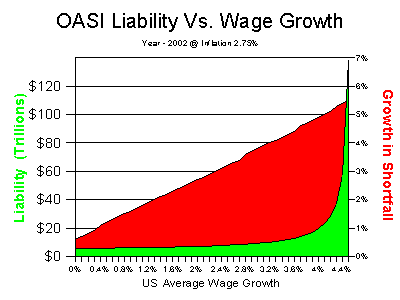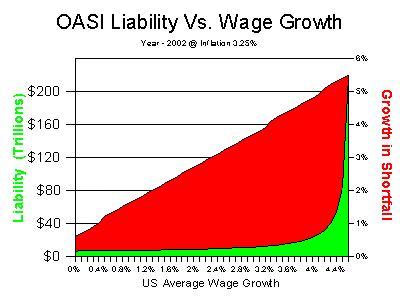
United States Wage Growth and Social Security
© William Larsen
Social Security uses inflation to adjust Social Security Benefits, but have you ever wondered how Social Security determines your initial benefit? Inflation is an index which is supposed to be a gage of how much a basket of predefined goods and services have changed in cost since the previous year. Social Security then indexes the benefits based on this change.
Social Security in a similar way uses the United States Average Wage Growth as an index to adjust OASI wages of previous years. It does this so each new cohort of retirees start with an equivalent percentage of life time wages as a benefit. SSA's example of low, mid and high wages. This link shows three different hypothetical wage categories for the a 62-year-old in 2002. Notice how the wages increase each year.
After your OASI wages have been identified for each year you have worked, they are indexed by the change in US wages. SSA's example of indexed wages. This link shows how a worker's wages, though much less years earlier are adjusted by the change in the U.S. Average Wage. What is interesting to note is, the low and mid wage earner have exactly the same wage after indexing for each year worked. Notice how the last years wage is the same as all previous year wages. The higher income workers have different values. This is due to the increasing the base to which Social Security tax is applied.
Social Security then takes the best 35 years and averages them. SSA's example of bend points. This link shows how the average indexed wage is used to determine an individual's initial monthly benefit. In the SSA's example a low wage earner making less than 45% of the mid level worker has a benefit which is 65% of the mid level workers benefit. The high wage earner paid 243% more in taxes than the low wage earner, but their benefit is only 115% larger. The OASI benefit is more generous to lower income workers. SSA's bend points and Chart shows how the more a person makes, the lower the replacement rate.
What few have known, is the U.S. Average Wage directly impacts the ability to pay future benefits in a negative way. As the SSA's example shows, previous wages are indexed to today's equivalent. This means if a spike in U.S. Wages occur, then all previous years wages are indexed by this spike. As one can see, if the U.S. Average Wage Growth were zero, then the initial OASI benefit would be the same across all retiree cohorts.
If the U.S. Average Wage increases faster than inflation, then each succeeding retiree cohort will retire with a larger initial OASI benefit. This is what causes a person who made the average wage and retired in 2000 have a slightly lower benefit than a person who made the average wage and retired in 2001. Is this cause for concern? Absolutely! The population of the United States has been increasing, but at ever slower rate of growth. The primary reason for this is the birth rate has been declining for two hundred or more years. The population is approaching zero growth. The result is a pay-as-go program cannot sustain itself. The Social Security Commission partially saw this soon-to-be-effect in 1983. The Commission recommended changes in the retirement age to 67 and a dramatic increase in the Social Security tax and base. The thought was to build up a fund to help pay the baby boomers when they retired.
What the Commission failed to understand or realize is as the U.S. Average Wage increased so did the initial Social Security benefit. It is some what difficult to explain, therefore, I have created a chart to show what happens when wages increase.
Figure 1 shows the unfunded liability for year 2002 with a 2.75% inflation rate
using a long term bond return of 5.6%. The U.S. Average Wage was
incremented at 0.1% up to what I refer to as the critical rate of return. The
unfunded liability is the difference between liabilities and assets. To arrive at
this number, the growth in the shortfall in 2080 was used to calculate a starting
fund balance large enough such that in 2080 the fund balance was growing at the
same rate as the shortfall. This particular set of assumptions finds at 5.6% wage
growth, the unfunded liability is over $130 Trillion. If the U.S. Average Wage
growth were to exceed 5.6%, then the fund would actually begin to loose money
and the current unfunded liability is infinite. The maximum rate of growth in
the U.S. Average Wage is limited to the Rate of Return earned on the Social
Security Trust fund. If the rate of return were to increase, then so could the U.S.
Average Wage Growth.

Figure 2 is the same set of variables, with inflation being set at 3.25% instead of 2.75%. This was to show what effect inflation has on the unfunded liability. Notice how the unfunded liability in 2002 has increased from $130 Trillion to over $220 Trillion due to a 0.5% increase in inflation.
At about 3.6% U.S. Wage Growth the unfunded liability begins to mushroom.
